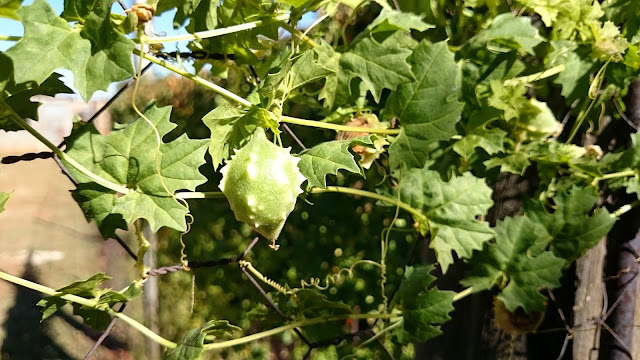Momordica Cardiospermoides Klotzsch
Family: Cucurbitaceae (pumpkin family)
Common names: bitter gourd (Eng.); inshubaba (siSwati); ntwe (seTswana)
This climber has a foetid smell, but makes up for it with showy orange-yellow flowers and large, fleshy, bulging orange-red ripe fruits that will attract birds to your garden.Description
Herbaceous climber with a perennial tuberous rootstock, all parts foetid. Rootstock consisting of several tough spindle-shaped, thickened roots covered with a yellow bark. Stems annual, several, much-branched, hairless, angular, up to 10 m long. Leaves short-stalked, compound, up to 120 mm long, deeply cut to the main vein, with about 10-20 leaflets; membranous, hairless, dark green above, paler below. Tendrils very thin, simple or split in two. Flowers either male or female, but on the same plant (monoecious), all stalked and solitary. Male flowers supported by a prominent sessile bract which is 10-20 mm wide, almost semi-circular, hairless, light green, with a few distinct longitudinal veins; corolla yellow to orange with greenish, raised veins outside, a dirty green near the base inside, 15-25 mm long. Female flowers with bract rather small or absent, corolla very similar to, but somewhat smaller than in male flowers. Fruit fleshy with a pink, gelatinous mucilage, more or less egg-shaped to sausage-shaped, smooth, hairless, dark green with lighter blotches when unripe, orange-red to scarlet when ripe, warty or bulging irregularly, indehiscent, 50-100 x 25-50 mm. Seeds many, rose-red turning crimson or dark brown when ripe, each covered with whitish soft flesh, more or less ovate-elliptic in outline, much compressed with a few irregular rows of flat warts or irregularly twisting ridges, about 12 mm long, about 8 mm wide and about 4 mm thick.
Distribution
M. cardiospermoides occurs from Tanzania, Malawi, Zambia, Zimbabwe, Mozambique and Botswana down to Swaziland and South Africa where it is found in the Limpopo, North-West (where I found mine), Gauteng and Mpumalanga provinces and in the Ingwavuma district in northern KwaZulu-Natal.
This species grows in well-drained sandy and sandy loam soil, among rocks on granite/gneiss outcrops, also on flat areas, along river banks and roadsides. It will grow in full sun, but prefers semi-shade among trees and shrubs. It is found in various types of woodland, savanna and wooded grassland vegetation and climbs onto all kinds of trees and shrubs, also on hedges and wire fences.
Derivation of the name
The genus name Momordica could perhaps refer to the sculptured seeds or the uneven appearance of the fruits, which look as if they had been bitten; the Latin mordeo means to bite. However, Jackson (1990) doubts this explanation. Momordica is an Old World genus of about 40 species, the majority of them in tropical Africa. They are recognized by the seeds that are almost always enveloped in reddish pulp and by the often prominent bracts subtending the male flowers.
The species name cardiospermoides refers to the resemblance of the compound leaves with those of Cardiospermum (Sapindaceae), the heart-seed or balloon-vine, also a climber. M. cardiospermoides was formerly known as M. clematidea Sond.; once again the species name refers to the compound leaves which also resemble those of Clematis (Ranunculaceae), another climber known as the traveller's joy. M. cardiospermoides is unique in the Cucurbitaceae in southern Africa in having compound leaves.
- Birds will certainly eat the brightly coloured and fleshy ripe fruit.
- Meeuse (1959) stated that 'the first flowers, male ones, as is the rule among the monoecious Cucurbitaceae, appear in late spring or early summer.
- Female flowers appear on the same plant usually one or two months later'.
- Most observers agree that M. cardiospermoides has a disagreeable smell, but a few collectors described the plant as fragrant!














